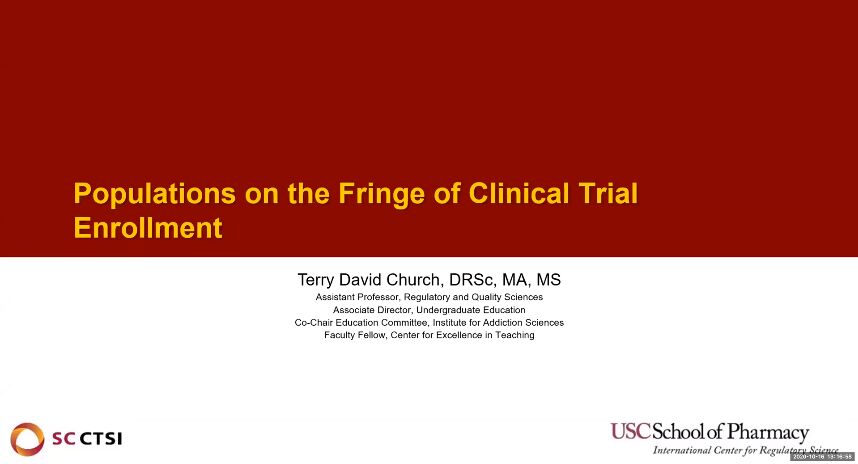1. Test
a. Questions will be generated through PollEverywhere (PollEv) throughout presentation
2. What comes to mind when you hear the word “Clinical Trial”
a. Word association with “Clinical Trial” for audience
i. Research, safety, efficacy, new, experimental therapies, human experiments
3. Clinical Trials are Crucial
a. In new therapies to understand outcome
b. In expanding or refining treatments
c. To identify behavioral changes
d. Help us better understand human health and outcomes
4. Clinical Trials Determine..
a. The patients we include will be the ones benefitting from the treatment
b. Exclusion of patients leads to knowledge gaps
i. Knowledge gaps lead to increased healthcare costs
5. PollEv: FDA created guidance on the collection of race and ethnicity data in clinical trials
a. Answer: true, posted in early 2000’s, put in place in 2016 with recommendations
6. FDASIA Section 907
a. Approved in 2013, directed FDA on how well they were documenting things like sex, age, race, ethnicity for medical products
i. Look into how demographic sub-groups are represented and sub-group safety and efficacy
7. FDA Action Plan
a. Outlined key issues in collecting data on demographic subgroup
b. Identify barriers to enrollment across clinical trials and employ strategies for greater participation
c. Make demographic sub-group data more available to public
8. FDA -Drug Trial Snapshot 2019
a. Demographic subgroup data
b. In 2019, 48 novel drugs had over 45,000 patients with U.S. representing 40% of individuals
9. PollEv. According to the Office of Management and Budget (OMB) standards, what is the recommended number of categories collected for clinical trial data for race and ethnicity?
a. Answer: 5 categories for race, 2 for ethnicity
10. Diversity Metrics for Research in the US
a. Set forth by OMB, so data is uniform in how it is presented
b. Census Bureau followed OMB guidelines for racial guidelines and mandated that categories had to be self-identified
11. Updating the Federal Statistics
a. Have to think about mixed race
b. Census Bureau and OMB working together, issued Federal Register Notice – separate questions for race and ethnicity, rephrase questions, add classification of Middle Eastern and North African
12. PollEv. Race is a social construct; therefore it is not necessary to be considered in clinical trial design
a. Answer: Although race is often considered to be a social construct, race can influence lifestyle and culture choices
13. Racial Composition
a. California is more diverse than other states
14. Age Composition
a. California has more young adults than national average
15. Gender Composition
a. California is one of the states that allows individuals to select “other”
16. Los Angeles County
a. Racially and ethnically diverse, with a broad spectrum of ages and sexes
17. Enumerating Los Angeles
a. About 10 million people in county
b. See 74,000 individuals (patients) at just USC in 2019
c. Only small fraction of patients (3% in nonclinical, 1% in clinical) enrolling in research studies
18. Zolpidem
a. Inadequate representation of information resulted in adverse outcomes and health disparities for underrepresented populations
b. Zolpidem nighttime dose had to be cut in half for women and elderly – were still experiencing effects when they woke up in morning
19. USC Undergraduates Research Associates Program
a. Operating in online format during COVID-19
b. Independent research is flourishing in undergraduate environment
c. This funding goes toward Underrepresented Populations in Clinical Trials
d. All results point to same direction: need for better inclusion
20. Inclusion of Pediatric Patients in Clinical Trials
a. Looked into number of drugs approved 2016-2018
b. Found lack of standardization in age group and lack of pediatric representation
c. Recommendation: better pediatric representation, improved safety, efficacy, labeling based on pediatric data
21. Low-Income Populations and Barriers to Diabetes Technology
a. Access to, and successful use of CGMs was evaluated
i. Emphasis on CA population and public insurance programs
b. Socioeconomic status was a criterion of trials (leads to underrepresentation of certain populations)
c. Recommendation: larger trials, move to proactive rather than reactive healthcare system
22. Chronic Diseases in Los Angeles County
a. Looked into racial and ethnic group enrollment in chronic disease studies
b. Limited clinical trial data in Los Angeles county for many chronic diseases
i. Hinted towards barriers to enrollment
c. Consider trials brought into Los Angeles County and evaluate those barriers
23. Race and Ethnicity in Mental Health Disorder Clinical Trials
a. Inclusion of variety of races and ethnicity in mental health trials is low
b. Unequal reporting and representation of race and ethnicity in study population
c. Conclusion: increased inclusivity helps improve mental health across the board
24. Anti-depressants Among Special and Vulnerable Populations
a. Vulnerable population: pregnant, special population: risk of suicide and individuals with diminished mental capacities
b. Trials only allow for enrollment of healthy individuals (excludes all those with mental health issues and pregnant women)
c. Need better clinical trial representation to provide more robust safety and efficacy information
25. PollEv. Clinical trial data should include social, cultural, and economic factors alongside race and ethnicity
a. Answer: true, to understand differences in disease response, dose scheduling, manifestation, need representation
26. What can we do?
a. Need diverse voices, diverse staff
b. Provide in-language and in culture materials
c. Broaden community engagement
d. Provide education and outreach to community (especially those who have history of non-participation)
e. Better reporting of data and findings to improve process of diversity, equity, and inclusion (DEI) in CT
27. Change the world together
a. Can do it one CT at a time
28. Acknowledgements
29. Thank You!/ Questions
Regulatory Science Symposium: Diversity in Clinical Trials in the Time of COVID-19 Session 6: Populations on the Fringe of Clinical Trial Enrollment
Study Design
Clinical Trials
Diversity
Inclusion
Barriers to Patient Access
Disparities in Research
Vulnerable Populations
Representation
Subject Eligibility Criteria
Course Syllabus/Topics
Acknowledgement
Accompanying text created by Annie Ly | Graduate Student, Regulatory Science, USC School of Pharmacy lyannie@usc.edu

